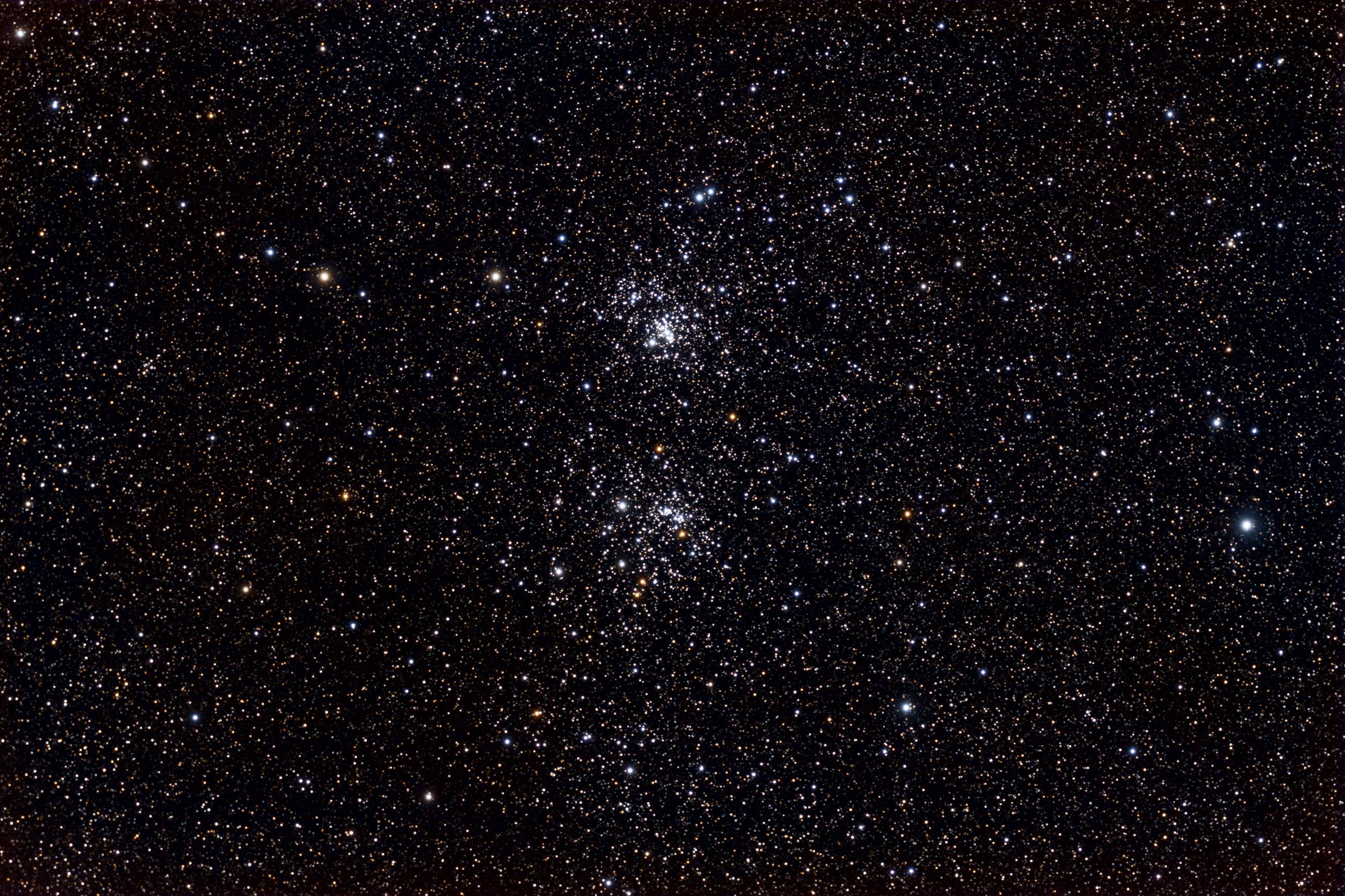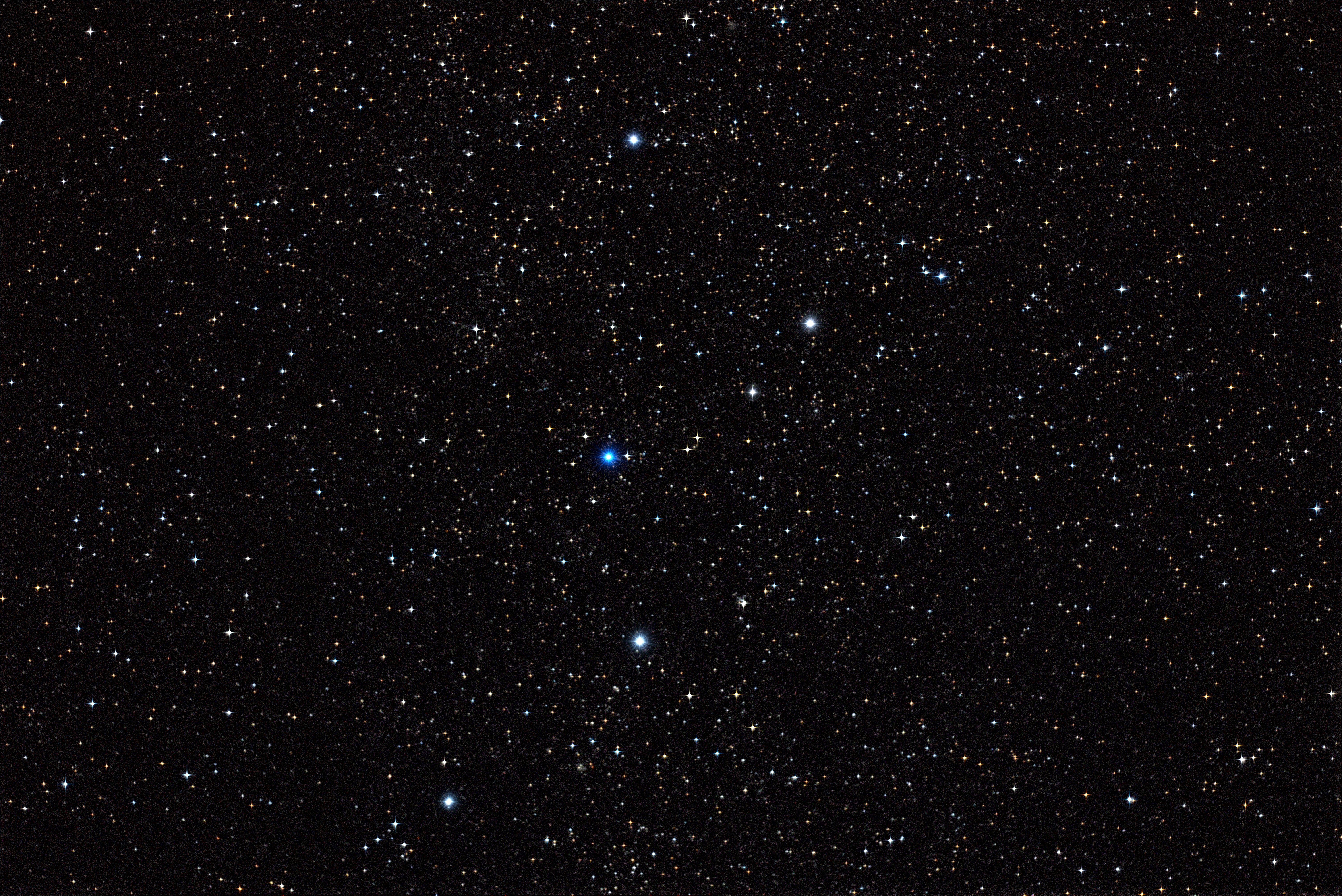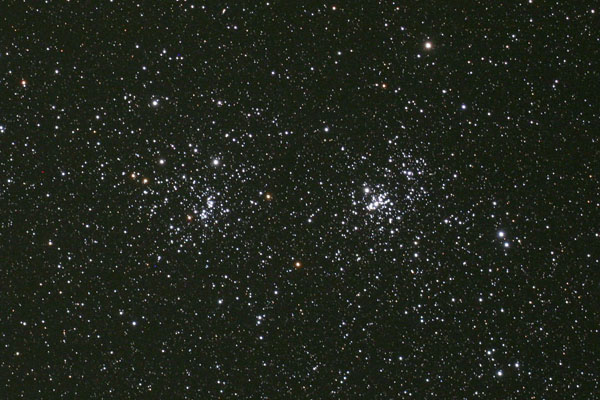|
Chi Per
NGC 884 (also known as χ Persei) is an open cluster located 7640 light years away in the constellation of Perseus. It is the east component of the Double Cluster with NGC 869. NGC 869 and 884 are often designated h and χ Persei, respectively.Some confusion surrounds what Bayer intended by these designations. It is sometimes claimed that Bayer could not have resolved the pair into two patches of nebulosity, and that Chi refers to the Double Cluster and h to a nearby star; see Stephen James O'Meara and Daniel W.E. Green, 2003, "The Mystery of the Double Cluster", ''Sky and Telescope'', Vol. 105, No. 2 (February 2003), p. 116–119. Bayer's ''Uranometria'' chart for Perseus does not show them as nebulous objects, but his chart for Cassiopeia does, and they are described as ''Nebulosa Duplex'' in Schiller's ''Coelum Stellatum Christianum'', which was assembled with Bayer's help; see Morton Wagman, ''Lost Stars'', McDonald & Woodward, 2003, , p. 240. The cluster is about 14 millio ... [...More Info...] [...Related Items...] OR: [Wikipedia] [Google] [Baidu] |
Double Cluster
The Double Cluster, also known as Caldwell 14, consists of the open clusters NGC 869 and NGC 884 (often designated h Persei and χ (chi) Persei, respectively), which are close together in the constellation Perseus. Both visible to the naked eye, NGC 869 and NGC 884 lie at a distance of about in the Perseus Arm of the Milky Way galaxy. Membership NGC 869 has a mass of 4,700 solar masses and NGC 884 weighs in at 3,700 solar masses; both clusters are surrounded with a very extensive halo of stars, with a total mass for the complex of at least 20,000 solar masses. They form the core of the Perseus OB1 association of young hot stars. Based on their individual stars, the clusters are relatively young, both 14 million years old. In comparison, the Pleiades have an estimated age ranging from 75 million years to 150 million years. There are more than 300 blue-white supergiant stars in each of the clusters. The clusters ... [...More Info...] [...Related Items...] OR: [Wikipedia] [Google] [Baidu] |
NGC 869
NGC 869 (also known as h Persei) is an open cluster located around 7,460 light years away in the constellation of Perseus. The cluster is around 14 million years old. It is the west component of the Double Cluster with NGC 884. NGC 869 and 884 are often designated h and χ (chi) Persei, respectively. Some confusion surrounds what Bayer intended by these designations. It is sometimes claimed that Bayer did not resolve the pair into two patches of nebulosity, and that χ refers to the Double Cluster and h to a nearby star. Bayer's '' Uranometria'' chart for Perseus does not show them as nebulous objects, but his chart for Cassiopeia does, and they are described as ''Nebulosa Duplex'' in Schiller's '' Coelum Stellatum Christianum'', which was assembled with Bayer's help.Morton Wagman, ''Lost Stars'', McDonald & Woodward, 2003, , p. 240. The clusters are both located in the Perseus OB1 association, a few hundred light years apart from each other. The clusters were first recorded by ... [...More Info...] [...Related Items...] OR: [Wikipedia] [Google] [Baidu] |
NGC Objects
The ''New General Catalogue of Nebulae and Clusters of Stars'' (abbreviated NGC) is an astronomical catalogue of deep-sky objects compiled by John Louis Emil Dreyer in 1888. The NGC contains 7,840 objects, including galaxies, star clusters and emission nebulae. Dreyer published two supplements to the NGC in 1895 and 1908, known as the ''Index Catalogues'' (abbreviated IC), describing a further 5,386 astronomical objects. Thousands of these objects are best known by their NGC or IC numbers, which remain in widespread use. The NGC expanded and consolidated the cataloguing work of William and Caroline Herschel, and John Herschel's '' General Catalogue of Nebulae and Clusters of Stars''. Objects south of the celestial equator are catalogued somewhat less thoroughly, but many were included based on observation by John Herschel or James Dunlop. The NGC contained multiple errors, but attempts to eliminate them were made by the ''Revised New General Catalogue'' (RNGC) by Jack W. ... [...More Info...] [...Related Items...] OR: [Wikipedia] [Google] [Baidu] |
Open Clusters
An open cluster is a type of star cluster made of tens to a few thousand stars that were formed from the same giant molecular cloud and have roughly the same age. More than 1,100 open clusters have been discovered within the Milky Way galaxy, and many more are thought to exist. Each one is loosely bound by mutual gravitational attraction and becomes disrupted by close encounters with other clusters and clouds of gas as they orbit the Galactic Center. This can result in a loss of cluster members through internal close encounters and a dispersion into the main body of the galaxy. Open clusters generally survive for a few hundred million years, with the most massive ones surviving for a few billion years. In contrast, the more massive globular clusters of stars exert a stronger gravitational attraction on their members, and can survive for longer. Open clusters have been found only in spiral and irregular galaxies, in which active star formation is occurring. Young open clusters may ... [...More Info...] [...Related Items...] OR: [Wikipedia] [Google] [Baidu] |
Caldwell Catalogue
The Caldwell catalogue is an astronomical catalogue of 109 star clusters, nebulae, and galaxies for observation by amateur astronomers. The list was compiled by Patrick Moore as a complement to the Messier catalogue. While the Messier catalogue is used by amateur astronomers as a list of deep-sky objects for observation, Moore noted that Messier's list was not compiled for that purpose and excluded many of the sky's brightest deep-sky objects, such as the Hyades, the Double Cluster ( NGC 869 and NGC 884), and the Sculptor Galaxy (NGC 253). The Messier catalogue was actually compiled as a list of known objects that might be confused with comets. Moore also observed that since Messier compiled his list from observations in Paris, it did not include bright deep-sky objects visible in the Southern Hemisphere, such as Omega Centauri, Centaurus A, the Jewel Box, and 47 Tucanae. Moore compiled a list of 109 objects to match the commonly accepted number of Messier objects ... [...More Info...] [...Related Items...] OR: [Wikipedia] [Google] [Baidu] |
Milky Way
The Milky Way or Milky Way Galaxy is the galaxy that includes the Solar System, with the name describing the #Appearance, galaxy's appearance from Earth: a hazy band of light seen in the night sky formed from stars in other arms of the galaxy, which are so far away that they cannot be individually distinguished by the naked eye. The Milky Way is a barred spiral galaxy with a Galaxy#Isophotal diameter, D25 isophotal diameter estimated at , but only about 1,000 light-years thick at the spiral arms (more at the bulge). Recent simulations suggest that a dark matter area, also containing some visible stars, may extend up to a diameter of almost 2 million light-years (613 kpc). The Milky Way has several List of Milky Way's satellite galaxies, satellite galaxies and is part of the Local Group of galaxies, forming part of the Virgo Supercluster which is itself a component of the Laniakea Supercluster. It is estimated to contain 100–400 billion stars and at least that number of pla ... [...More Info...] [...Related Items...] OR: [Wikipedia] [Google] [Baidu] |
Cassiopeia Constellation
Cassiopeia () is a constellation and asterism in the northern sky named after the vain queen Cassiopeia, mother of Andromeda, in Greek mythology, who boasted about her unrivaled beauty. Cassiopeia was one of the 48 constellations listed by the 2nd-century Greek astronomer Ptolemy, and it remains one of the 88 modern constellations today. It is easily recognizable due to its distinctive ' W' shape, formed by five bright stars. Cassiopeia is located in the northern sky and from latitudes above 34°N it is visible year-round. In the (sub)tropics it can be seen at its clearest from September to early November, and at low southern, tropical, latitudes of less than 25°S it can be seen, seasonally, low in the North. At magnitude 2.2, Alpha Cassiopeiae, or Schedar, is the brightest star in Cassiopeia. The constellation hosts some of the most luminous stars known, including the yellow hypergiants Rho Cassiopeiae and V509 Cassiopeiae and white hypergiant 6 Cassiopeiae. In 1572, Tycho ... [...More Info...] [...Related Items...] OR: [Wikipedia] [Google] [Baidu] |
Hipparchus
Hipparchus (; , ; BC) was a Ancient Greek astronomy, Greek astronomer, geographer, and mathematician. He is considered the founder of trigonometry, but is most famous for his incidental discovery of the precession of the equinoxes. Hipparchus was born in Nicaea, Bithynia, and probably died on the island of Rhodes, Greece. He is known to have been a working astronomer between 162 and 127 BC. Hipparchus is considered the greatest ancient astronomical observer and, by some, the greatest overall astronomer of classical antiquity, antiquity. He was the first whose quantitative and accurate models for the motion of the Sun and Moon survive. For this he certainly made use of the observations and perhaps the mathematical techniques accumulated over centuries by the Babylonians and by Meton of Athens (fifth century BC), Timocharis, Aristyllus, Aristarchus of Samos, and Eratosthenes, among others. He developed trigonometry and constructed trigonometric tables, and he solved se ... [...More Info...] [...Related Items...] OR: [Wikipedia] [Google] [Baidu] |
Perseus OB1
Perseus OB1 is an OB association in the Northern Celestial Hemisphere in the constellation Perseus. It is centered around the double cluster (NGC 869 and NGC 884), and has lent its name to the Perseus Arm of the Milky Way. The brightest member of the association is the blue supergiant A blue supergiant (BSG) is a hot, luminous star, often referred to as an OB supergiant. They are usually considered to be those with luminosity class I and spectral class B9 or earlier, although sometimes A-class supergiants are also deemed blu ... 9 Persei. References Stellar associations Carina (constellation) Perseus (constellation) {{star-cluster-stub ... [...More Info...] [...Related Items...] OR: [Wikipedia] [Google] [Baidu] |
Coelum Stellatum Christianum
The ''Coelum Stellatum Christianum'' is a star atlas published in 1627 by Julius Schiller ( 1580–1627), with the collaboration of Johann Bayer (1572–1625). In the treatise, which was published by Andreas Aperger at Augsburg during the same year as Schiller's death, pagan constellations were replaced with biblical figures and Christian motifs. Schiller replaced the zodiac constellations with the Twelve Apostles, the northern constellations with New Testament figures, and the southern constellations with Old Testament figures. The planets, the Sun, and the Moon were also replaced by biblical figures: *The Sun is replaced by Jesus Christ. *The Moon is replaced Mary (mother of Jesus), Mary. *Mercury (planet), Mercury is replaced by Elijah. *Venus is replaced by John the Baptist. *Mars is replaced by Joshua. *Jupiter is replaced by Moses. *Saturn is replaced by Adam. The engravings in the atlas were by Lucas Kilian. Constellations New Testament In general, New Testament figures an ... [...More Info...] [...Related Items...] OR: [Wikipedia] [Google] [Baidu] |
Perseus Constellation
Perseus is a constellation in the northern sky, named after the Greek mythological hero Perseus. It is one of the 48 ancient constellations listed by the 2nd-century astronomer Ptolemy, and among the 88 modern constellations defined by the International Astronomical Union (IAU). It is located near several other constellations named after ancient Greek legends surrounding Perseus, including Andromeda to the west and Cassiopeia to the north. Perseus is also bordered by Aries and Taurus to the south, Auriga to the east, Camelopardalis to the north, and Triangulum to the west. Some star atlases during the early 19th century also depicted Perseus holding the disembodied head of Medusa, whose asterism was named together as ''Perseus et Caput Medusae''; however, this never came into popular usage. The galactic plane of the Milky Way passes through Perseus, whose brightest star is the yellow-white supergiant Alpha Persei (also called Mirfak), which shines at magnitude 1.79. It and man ... [...More Info...] [...Related Items...] OR: [Wikipedia] [Google] [Baidu] |
New General Catalogue
The ''New General Catalogue of Nebulae and Clusters of Stars'' (abbreviated NGC) is an astronomical catalogue of deep-sky objects compiled by John Louis Emil Dreyer in 1888. The NGC contains 7,840 objects, including galaxy, galaxies, star clusters and emission nebulae. Dreyer published two supplements to the NGC in 1895 and 1908, known as the ''Index Catalogues'' (abbreviated IC), describing a further 5,386 astronomical objects. Thousands of these objects are best known by their NGC or IC numbers, which remain in widespread use. The NGC expanded and consolidated the cataloguing work of William Herschel, William and Caroline Herschel, and John Herschel's ''General Catalogue of Nebulae and Clusters of Stars''. Objects south of the Celestial sphere, celestial equator are catalogued somewhat less thoroughly, but many were included based on observation by John Herschel or James Dunlop. The NGC contained multiple errors, but attempts to eliminate them were made by the ''Revised New Ge ... [...More Info...] [...Related Items...] OR: [Wikipedia] [Google] [Baidu] |







